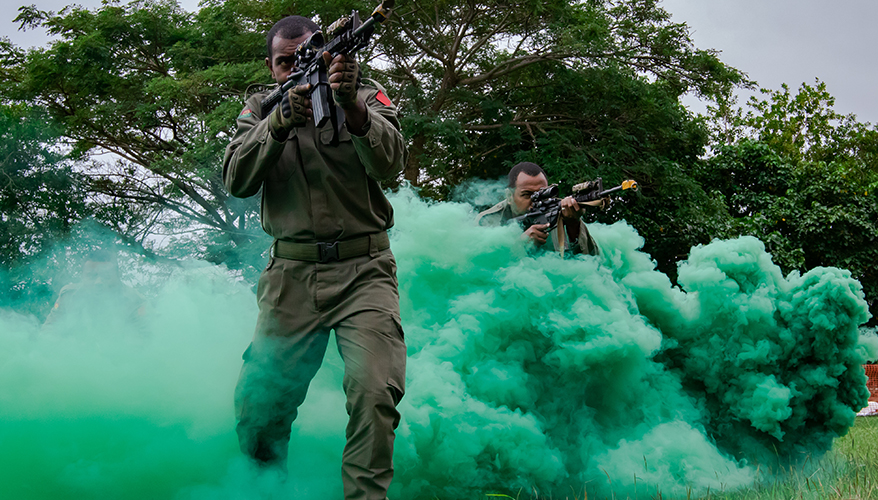LAND FORCES
JUST IN: Indo-Pacific Exercises Present Necessary Challenges for Army
By Laura Heckmann

Army photo
Following a month-long tour across seven countries in the Indo-Pacific, the commander of Army Pacific Command said one of the best ways to combat the region’s logistical land issues is through partnerships and exercises, but they have logistical challenges of their own.
Giving an example of the challenges to land logistics in the Indo-Pacific, Army Gen. Charles Flynn told reporters May 8 about two exercises conducted the beginning of the year in Thailand while simultaneously moving equipment and other capabilities into the Philippines from “Alaska, Hawaii and even the West Coast … and at the same time, we’re repositioning assets out of Thailand into the Philippines” for Balikatan — an annual military exercise between the Philippines and the United States.
Once Balikatan concludes, Army assets will remain through yet another exercise until July, at which point assets will be moved from the Philippines to Indonesia until August and then from Indonesia to Japan for exercise Orient Shield, Flynn said. He also mentioned exercise and training conducted in the Korean Peninsula “day in and day out” that many don’t see.
For example, he said, “We recently rotated out the Stryker Brigade, which is another big move from the continental United States over to the Korean Peninsula, and then the redeployment of another one, and then the positioning of other smaller assets.”
Talisman Sabre, the largest bilateral military exercise between Australia and the United States, included joint logistics over-the-shore and joint petroleum over-the-shore operations and served as a rehearsal for “what you see over in Gaza right now,” Flynn said.
“We actually rehearsed that with the very brigade that is doing that in the Middle East during Talisman Sabre,” he said. “So, I guess I'm just trying to describe here that a road march from one country to another country through connected roads, I guess that’s what they can do in Europe. But what I'm describing is movements between South Asia, Northeast Asia, the first island chain, Southeast Asia, Australia.”
Flynn said he wanted to emphasize the necessity of multimodal transportation. “So, this is commercial air, this is military air, this is military sealift command, this is Army watercraft, this is inland transportation, this is port opening capability.”
All are part of strategic readiness, he said. “Because what we’re doing is we’re translating strategic movement into operational maneuver inside the Indo-Pacific [area of responsibility] from the Asian continent, connected by the archipelago land bridge of Southeast Asia that connects the other continent that's out here, Australia, and then of course, all the operations that we do day to day in the northern tip of the first island chain and on the Asian continent between Japan and South Korea.”
Flynn said foot marching from one country to another “is great” if you’re going through NATO countries, but “if you can just think about the expansive nature of movement and maneuver, and the logistics required to tie all that together, it is extraordinary what we do out here.”
Flynn said Operation Pathways, Army Pacific Command’s annual joint campaign to rehearse operational and strategic movement throughout the Pacific, is “essentially campaigning” with the land power network that exists in the region.
“These countries have large armies,” with Thailand, the Philippines and Indonesia’s armies comprising more than 70 percent each of their militaries, he said. “The point I'm making here is this is where we connect out here. This is where the land power network is the security architecture that binds this region together. And if you think about the movement that I was just describing right there, that is Operation Pathways, that is campaigning. That is, in time and space, tying together operations, activities and investments that benefit the U.S. national security objectives and those of our allies and partners.”
Flynn said Operation Pathways “is the very definition of campaigning, and what I was just describing … are very real and concrete examples of campaigning with land forces in support of the joint force out here and the allies and partners and the combined forces across Asia.”
He called the logistics of coordinating exercises in the Indo-Pacific “incredibly challenging,” from host nation agreements to timing to air coordination. “It's absolutely a 24/7, 365 body of work,” but it's also a good problem to have, he said.
“Because all of this takes multinational work and multilateral coordination.” Agreements like the U.S./Republic of Korea/Japan agreement and other trilateral agreements are “incredibly important as bodies of coordination for us to be able to capitalize on one another’s strengths.”
Topics: Army News, Land Forces, Logistics
